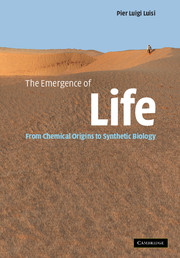Book contents
- Frontmatter
- Contents
- Preface
- Acknowledgments
- List of books on the origin of life
- 1 Conceptual framework of research on the origin of life on Earth
- 2 Approaches to the definitions of life
- 3 Selection in prebiotic chemistry: why this … and not that?
- 4 The bottle neck: macromolecular sequences
- 5 Self-organization
- 6 The notion of emergence
- 7 Self-replication and self-reproduction
- 8 Autopoiesis: the logic of cellular life
- 9 Compartments
- 10 Reactivity and transformation of vesicles
- 11 Approaches to the minimal cell
- Outlook
- References
- Index
10 - Reactivity and transformation of vesicles
Published online by Cambridge University Press: 17 December 2010
- Frontmatter
- Contents
- Preface
- Acknowledgments
- List of books on the origin of life
- 1 Conceptual framework of research on the origin of life on Earth
- 2 Approaches to the definitions of life
- 3 Selection in prebiotic chemistry: why this … and not that?
- 4 The bottle neck: macromolecular sequences
- 5 Self-organization
- 6 The notion of emergence
- 7 Self-replication and self-reproduction
- 8 Autopoiesis: the logic of cellular life
- 9 Compartments
- 10 Reactivity and transformation of vesicles
- 11 Approaches to the minimal cell
- Outlook
- References
- Index
Summary
Introduction
Vesicles are commonly considered models for biological cells. This is due to the bilayer spherical structure which is also present in most biological cells, and to the fact that vesicles can incorporate biopolymers and host biological reactions. Self-reproduction, an autocatalytic reaction already illustrated in the chapters on self-reproduction and autopoiesis, also belongs to the field of reactivity of vesicles. Some additional aspects of this process will be considered here, together with some particular properties of the growth of vesicles – the so-called matrix effect.
Simple reactions in liposomes
Preliminary to biological studies is the incorporation of biopolymers and other reagents in the water pool of vesicles. For reasons which have been illustrated in the previous chapter, one cannot rely on the spontaneous diffusion of solute inside the liposomes, mostly due to the poor permeability of the liposome membrane. Only occasionally, depending upon the chemical nature of the solute and/or the lipid surfactant, some restricted and selective permeability is observed. In the experiment illustrated in Figure 10.1, an apolar molecule is capable of permeating inside, where it reacts with phosphate ions by opening of the ring: the product, being now polar, is trapped inside. In this case, although the permeability is very low, the irreversible chemical transformation of the reagent inside the liposomes drives the incorporation process. Another example is the slow permeation of adenonine diphosphate (ADP) inside liposomes.
- Type
- Chapter
- Information
- The Emergence of LifeFrom Chemical Origins to Synthetic Biology, pp. 214 - 242Publisher: Cambridge University PressPrint publication year: 2006



